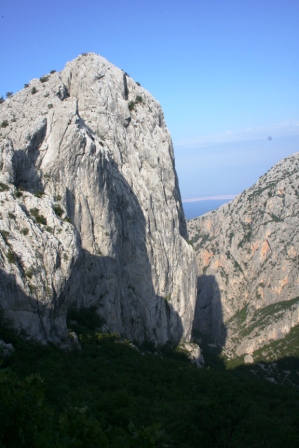Velika Paklenica EarthCache
-
Difficulty:
-

-
Terrain:
-

Size:  (not chosen)
(not chosen)
Please note Use of geocaching.com services is subject to the terms and conditions
in our disclaimer.
This Earthcache is dedicated to The Velika Paklenica Valley, which was declared a national park in 1949 The valley is 14 km long and 500-800 metres wide. In the narrowest part it has only 50 metres. Vertical cliffs are almost 700 metres high.

Near the sea in a beautiful Croatian mountains called Velebit, there is hidden a great mystery of ages. It is written in a nice valley of Velika Paklenica. The story is connected with a glacial ages and with the great power of water, wind and gravitation.
To explain how the valley was created we have to travel back in time, around million years. During that time there were several glacial periods. Decomposing of rock was then far more expressed than it is today. Underground water channels weren’t yet formed and there was no forest. Rains and snows were plentiful making surface flows and erosion very strong, tectonics were stronger too, all of which ultimately led to formation of Paklenica canyon. In that time the sea level must have been 120 lower than today at the time, and nearby Velebit Channel (nowadays it is a sea) was a wide valley with a river flowing through it. The highest parts of Velebit were covered with glaciers.

Due to the gravitation a glacial tongue of the glacier proceeded further downslope towards the sea leaving behind the signs of his work. What we can find nowadays are the remains of the end moraine of the glacier. It was a Early or middle Wurmian glatiation in the Velika Paklenica valley.
Suprisingly the end of a moraine occurs in the Velika Paklenica Canyon at abot 250 m a.s.l., because usually it is in the higher altitude, about 800 m. The moraine consist mainly of very large limestone pebbles and boulders (more than 20 m in diameter).

The area of a whole park is famous also due to karst relief with an abundant subterranean natural beauty. You can find here 37 caves and 39 pits. Only the Manita Pec Cave is currently opened for visitors. Its entrance (540m) is placed in the cliffs of Velika Paklenica,. Cave consists of two large halls and is 175m long and 35m deep. Limestone melted in water sediments again and creates stalactites and stalagmites. Some of them are 20m high.

Unlike the rest of thirst Velebit mountains, Paklenica has many permanent springs and several permanent or occasional flows. Watertight sediments are situated beneath very porous karstic deposits of carbonate rock. That’s why this vally looks so green and you can breathe here a nice mountain air.

To be able to fulfill the tasks you have walk through the educational path in the valley of Velika Paklenica to the hut “Dom u Paklenici”. The walk there and back is a 6 km long, which takes about 4 hours and you can do it also with children 10+ years old, like a alternative to the catching sun during vacation at the Croatian coast. The walk goes through the valley by almost “paved” path. There 2 springs of water and two huts where it is possible to buy something to drink and also to oversleep the night. Note there is a small lake along the way before the second spring, where maybe you will try to swim, if you dare.

The entrance to the valley requires access fee for the National Park Paklenica. During hot summer I strongly recommend to start the journey early in the morning, e.g. at 5.00 AM.
From November 2010 I ask you to add the best photo of Velika Paklenica valley you made, may be with your friends, or just nature. To be sure you were there, you can also add the photo of yourself with your GPSr before the hut “Dom u Paklenici”. Temporarily send the copy of the email also to my profile email.
To claim this cache you have to send answers on these 4 questions:
1. Which animal of the inhabitants of the Paklenica National Park is in the European Red List of Endagered Species? (Look at the board by the Paklenica Hut)
2. Who lead one of the first biological investigations in the caves in this part of Velebit mountains?
3. What’s the length of the longest speleological object in Paklenica? (the length differs from internet sources:)
4. What signs of glacial activity or erosion have you found in the valley? Describe it in your email. If you want post a photo with one of them in your log.
After sending me the answers via profile (please attach your email), you can log the earthcache. In case the answers are insuficient, I will contact you.

Additional Hints
(No hints available.)